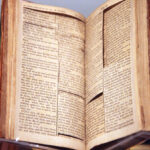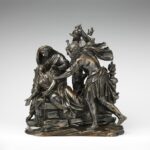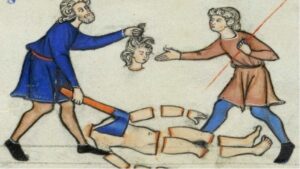Texts of Terror
When I was a teenager, one of my classmates who is a peace-loving Buddhist asked me a question in school, “Why is a Christian hymn so violent?” I replied to him, “how so?” He accidently heard, “Stand Up for Jesus” on the radio and thought that the lyrics are very violent. Without recalling the lyrics of the hymn, I quickly defended the hymn as I was a soldier to protect the sacred words. I explained to my friend that the fight in the hymn is to be understood as a fight against Satan, not other human beings. Then when I came back home, I immediately looked at the lyrics of the hymn closely:
I realized that other people could have different views and questions on the things that I have never questioned. I grew up with this hymn, so I accepted this without any questions, or resistance, or even deeply thinking about the meanings of lyrics. Then I recalled some violent stories in the Bible such as the first murder in Genesis 4, the dismembered concubine in Judges 19, Judas’ death in Matthew 27 & Acts 1, John the Baptist’s beheading in Mark 6, and the conquest story in Joshua. I decided to revisit these texts again. As I read them more closely, these scriptures struck me that there are way more violent elements in Christianity than I ever thought.
“Source bible for the Jefferson Bible – Smithsonian Museum of American History – 2012-05-15” by Tim Evanson is licensed under CC BY-SA 2.0. To view a copy of this license, visit https://creativecommons.org/licenses/by-sa/2.0/?ref=openverse.
About that time, one of the speakers at a retreat spoke about the danger of fixing the Bible by adding to or subtracting from it; the preacher believed that the Bible is the inerrant word of God and should not be altered in any way. He strongly believed that the third president, Thomas Jefferson, was a heretic because he used his knowledge as a scissor to cut off the biblical verses he had problems with. The preacher highlighted that Mr. Thomas Jefferson created a canon within a canon, within a canon, the Jefferson Bible,[1] and we should never be like him. As I grew up and explored more parts of the Bible, I had some unanswered questions, but I was afraid to ask questions openly because I did not want to be viewed as a heretic. However, I began to ignore some verses internally. It was as if I was untethering myself from the difficult passages, especially the texts of terror.
“Selective untethering reader” internally and “uncritical acceptance reader” externally
Until I received theological education, I sometimes read the Bible as a “selective untethering reader” internally and an “uncritical acceptance reader” externally. A selective untethering reader is someone who reads like Thomas Jefferson. The reader does not believe in all stories in the Bible. Thus, the reader picks and chooses the stories that make sense to them. On the other hand, an uncritical acceptance reader does not question or challenge the passages in the Bible even if they are troublesome. When I compare my internal and external type of reading, internal means what is inside my own mind, and external is my public kind of reading.

“The sacrifice of Jephthah’s daughter” by Massimiliano Soldani is marked with CC0 1.0. To view the terms, visit https://creativecommons.org/publicdomain/zero/1.0/?ref=openverse.
I did not bother to ask many questions externally since conservative Korean Protestantism, which is my tradition, is more on the uncritical acceptance reader side. I simply accepted the texts even if the texts might seem troublesome ethically. I was taught not to question the truth of God’s words, or even the words of teachers and pastors. They usually highlighted the good lessons from the stories although the texts are still problematic. For instance, when the teachers addressed the daughter of Jephthah’s story in Judges 11, they focused on the sacrifice of Christians to glorify God rather than questioning the texts about the horrific domestic violence. Using a different approach, Phyllis Trible, who is a feminist biblical scholar, theologian, and author, refers to the story of Jephthah’s daughter as “tales of terror” and and and reinterprets the story in her book, Texts of Terror.[2]
How to Be Engaged in Difficult Texts: Applying a Four Step Approach
Then how do we avoid being an uncritical acceptance and a selective untethering reader simultaneously? How can we read the Bible by fully engaging with biblical texts, even the troublesome ones? I intend this D.Min. project to help Christians from Korean Protestant traditions, especially people like me in the past, to understand how to engage difficult texts. I will highlight the significance of theological stories by using a four step approach to engaging the difficult texts.
Step 1: Asking honest questions by wrestling with the text
The first step is asking honest questions by wrestling with the text. What questions do we have about the text? This step is important because we can deeply think about questions we never thought about or address the questions we were afraid of speaking out about because of other people’s view. Before we ask honest questions, we can wrestle with the texts to get closer to the author’s intent for the text. We can also wrestle with other interpreters and how they have interacted with this story. For example, we can ask why is a biblical character who displays domestic violence in Judges 11 is portrayed as a man of faith in Hebrews 11?
Step 2: Extending charity by listening carefully
The second step is extending charity to biblical texts by listening carefully. By doing this step, we can discover that the text leaves open the possibility of a different result. By listening carefully, we can discover that the text leaves open the possibility that a biblical character was not actually killed, because the text does not narrate the character being killed explicitly. By extending charity, we can also view the text of terror in a different angle. For example, we can try to understand and emphasize with a character who terrorizes in the text.
Step 3: Creating a conversation with other texts both in and outside the Bible
The third step is creating a conversation with other texts both in and outside of the Bible. It is crucial to bring other texts into the conversation about the texts of terror because we might be able to solve some mysterious puzzles and hidden meanings of the text by engaging in the other stories. If our main text includes child sacrifice, for example, we can argue that God does not want child sacrifice by creating a conversation with other biblical texts that prohibit child sacrifice: Leviticus 18:21, 20:2-5, and 2 Kings 23:10.
By interacting with non-biblical sources, we can imagine and understand the perspectives of other people’s view and understand and remember the biblical text better in a practical viewpoint. The books I recommend for the non-biblical sources about child sacrifice are listed at the bottom of this page.
Step 4: Responding from context
The last step is responding from context from the biblical narrative. We can find a context from a biblical narrative and respond from it. For example, we can discover an annual ritual about remembering a biblical character from the narrative and talk about what the ritual means and symbolizes. We can also respond from context that the character and her supporters are examples of solidarity in the face of violence from men, of lament in the face of the horrors of history, and of great companions to support each other no matter what happened. The context can be enriched by incorporating sources from a biblical commentary.
Why is using the four step approach important?
As a result of applying the four step approach, we will be able to read the Bible by fully engaging with biblical texts, even the difficult ones. By fully engaging with the biblical texts, we will be able to avoid being an uncritical acceptance and a selective untethering reader simultaneously. We will also be able to avoid neglecting someone like a biblical character who was being marginalized in society.
Reference:
[1] Jefferson, Thomas. The Jefferson Bible. New York: Holt, 1904.
[2] Trible, Phyllis. Texts of terror: literary-feminist readings of Biblical narratives. Philadelphia: Fortress Pr., 1997, 1.
For Further Reading:
Collard, Christopher, and James Morwood, eds. “INTRODUCTION.” In Euripides: Iphigenia at Aulis: Volume 1: Introduction, Text and Translation; Volume 2: Commentary and Indexes, Liverpool University Press, 2017. https://doi.org/10.2307/j.ctv160bt40.5.
Trible, Phyllis. Texts of terror: literary-feminist readings of Biblical narratives. Philadelphia: Fortress Pr., 1997.
Yoon, KyungAh. Korean Through Folktales. Minneapolis: Portland State University Library, 2017.
